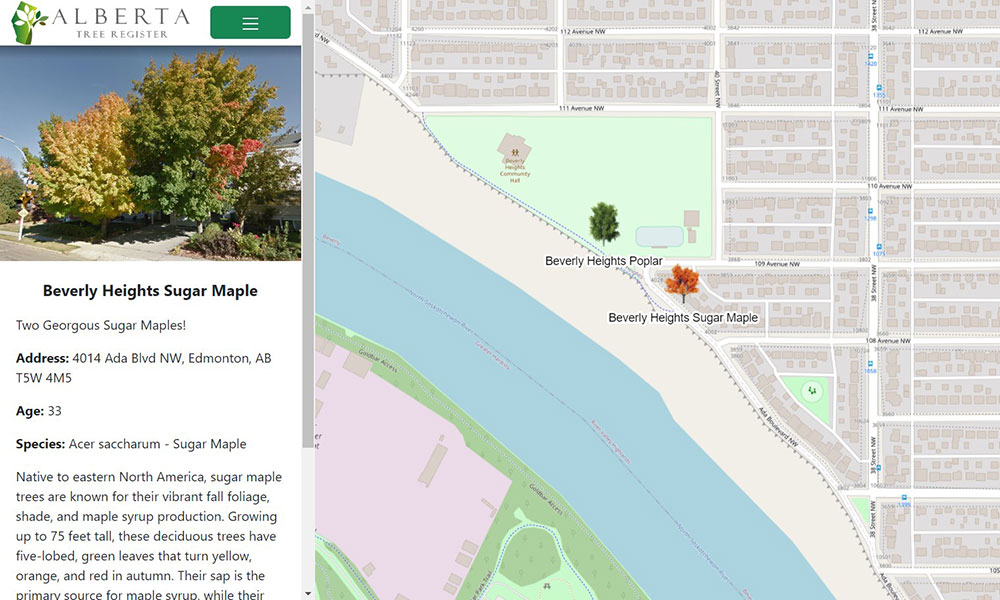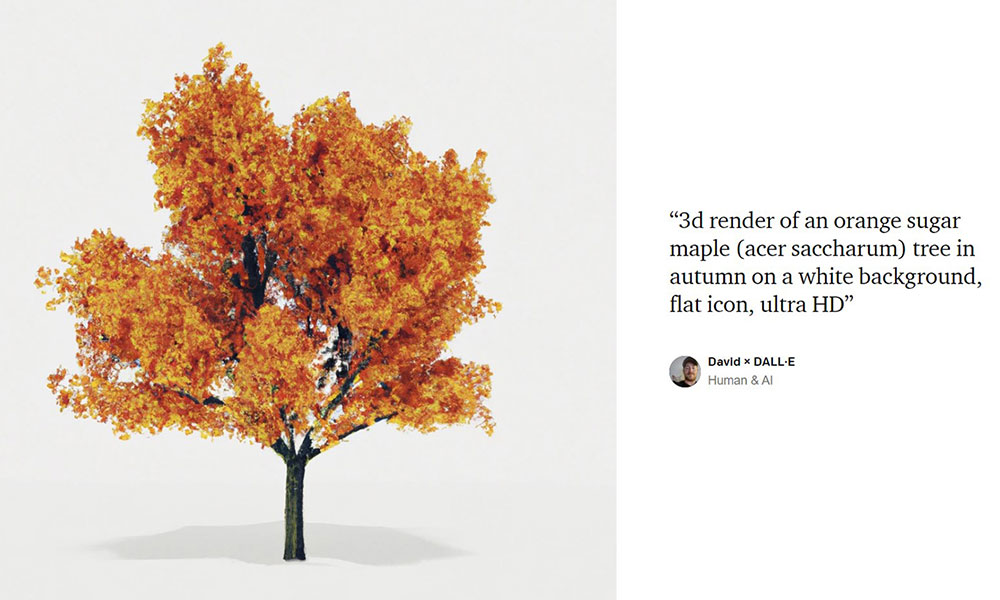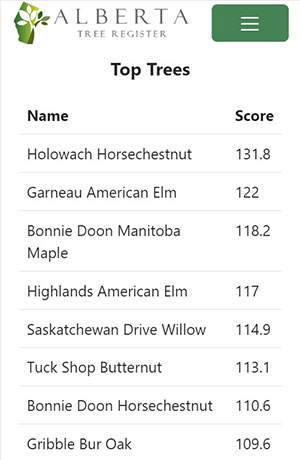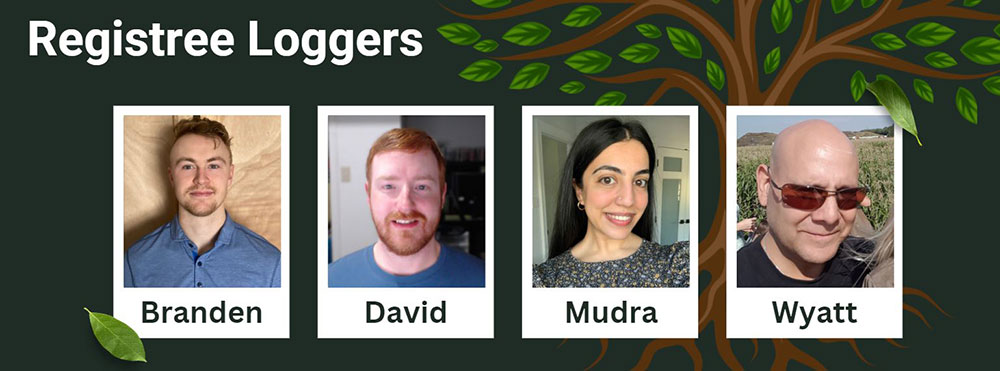Database and app tell the story of special plants – and of us
Do you know the story of the trees in your neighbourhood?
A new app, with roots dating back more than a decade, aims to bring those stories to the public by gathering profiles of hundreds of Alberta’s “heritage trees” and placing them all on one interactive digital map.
The Alberta Tree Register was developed by Edmonton-based nature aficionado Dustin Bajer, along with the help of David Desjarlais (Computer Engineering Technology ’11), Wyatt Foley (Mechanical Engineering Technology ’21), Branden Klatt (Occupational Health and Safety ’21) and Mudra Bokhiria (Digital Media and IT ’21).
The four NAIT students spent the 2022-23 academic year working on the register as their capstone project, the final piece of their studies in the Bachelor of Technology program. (All four students are also part of the '23 BTech graduating class.)
To some, trees may not seem so mysterious or interesting, which can be a challenge to their protection. But Bajer believes the story of which trees survive in a city – both native species and the ones imported from elsewhere – are a way of understanding how humans have adapted in that place, too.
“The plants in our city are reflections of the occupants and our values,” Bajer says. “Highlighting some of those stories is a way of telling a story about ourselves.”
An idea takes root

Trees have been a part of Bajer’s life from a young age. He grew up on an acreage with easy access to a nearby forest, and went on to work at a botanic garden. He also has certificates in both gardening and permaculture.
“I feel at home amongst trees,” Bajer says, pointing out that many other Albertans do, too – since 60% of this “prairie” province is covered in forest.
In 2021 Bajer started Shrubscriber, a network that grows and donates trees to schools and community groups in the name of increasing biodiversity, food security and beauty, while also making Edmonton a more liveable and climate-resilient city.
That work got him thinking about what’s known as “heritage trees” – a broad category that includes trees that are unusually old or large, or that have historical or cultural value to their area.
A different group first attempted to catalogue Alberta’s heritage trees around fifteen years ago, Bajer says, but when their database crashed the group disbanded. He wanted to carry on that work, but all that was left was a mass of incomplete information.
“We basically had a whole bunch of fragmented documents,” he says.
What was needed was someone – perhaps multiple people – who could take those disparate, unwieldy data sets and put them all in the same format, thereby allowing the tree database to really take root.
Enter: NAIT’s capstone students.
A helping hand from AI

At first, the plan was for the student quartet to simply help Bajer categorize his data. As Foley put it, “I thought my job was just to spit out some tables.”
Soon, however, the group realized the project had much more potential. Bajer had worked with NAIT students on several other capstone projects in the past, and he’d always been impressed by their work ethic and creativity. And so, over weekly meetings, the group decided to pool their other skills and see what they could use the data to do.
For Foley, that meant researching the qualities that give a particular tree heritage value, and putting together a how-to guide for users to submit their own trees to the database.
And for Desjarlais, who had previous experience coding, it meant creating a map that would interface with the data – which would eventually become the foundation for the Alberta Tree Register app.
“It was one of our big goals to find a way to not only gather the data into one source, but display it and make it visible to the public,” says Desjarlais.
A one-of-a-kind degree
NAIT's Bachelor of Technology is unique in Alberta in that it links technology skills with management strategies, pointing to careers in leadership.
Learn more
If people had an easy way of learning more about the significant trees in their communities, the group figured, they would become more interested in local ecology and history, and more invested in protecting those trees from future threats.
For most of the project, Desjarlais was busy on his initial tasks. It wasn’t until March that his schedule opened up and he had time to pitch something more ambitious.
“I wanted to push really hard to have something to show off,” he says. “So I took everything we’d talked about, all the ideas, and put them together” into the app.
At this point, time was a factor, so Desjarlais turned to an unlikely collaborator: artificial intelligence.
With the help of the AI chatbot ChatGPT, Desjarlais was able to generate all of the basic code for the app within 72 hours; using a separate AI model called DALL-E, he was able to generate illustrations for each species of tree to populate the individual entries.
This was Desjarlais’s first time leaning on AI to help with coding – which at this point he hadn’t done professionally for a number of years – and he was blown away by the results.
“It was crazy to me, because [the chatbot] would give you step-by-step instructions,” he says. “It explains how the code works, and you can even prompt it and ask for alternatives, and whether those alternatives are free or cost money.
"I used it for analysing and developing literally every aspect of the app.”
 464 trees and growing
464 trees and growing
From here, the Alberta Tree Register is ready to grow.
It currently lists a total of 464 trees, but the overwhelming majority of those are in Edmonton. Bajer, Desjarlais, Foley and the other students are hoping that users will fill out the form on the app and suggest other trees across the province to be added in the near future.
Even though their official work on the project is complete, Foley says that all four of the capstone students plan to stay on in an informal capacity and continue to be part of the heritage-tree community.
“Now that we’ve got this going, we want to see how far it can be taken,” he says.
The project has also given the students newfound appreciation for the trees in their immediate vicinity.
Foley and his daughter are now looking into how her school can get involved with Shrubscriber’s tree kits, and Desjarlais says he’s become interested in stepping away from the computer and getting his hands dirty.
“I learned quite a lot about what value trees bring, both to human communities and the general ecosystem,” Desjarlais says.
“It made me want to go plant some trees myself.”
